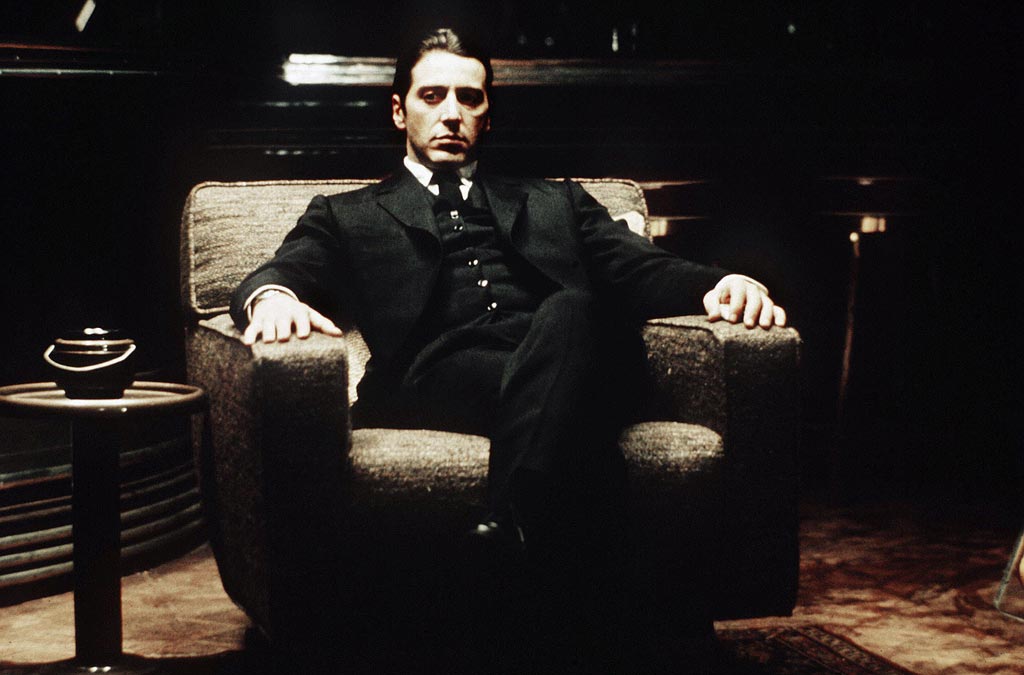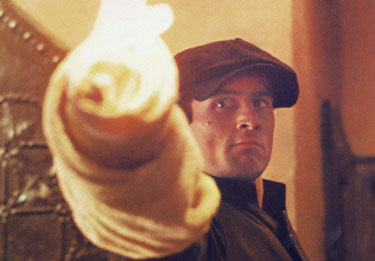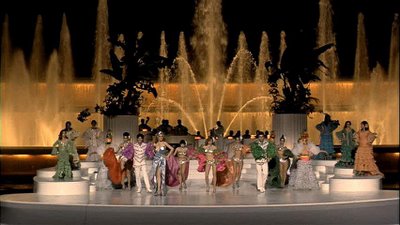From Sight and Sound (Summer 1975). I think I probably did a better job with The Godfather 33 years later, when I wrote something about it for Filmkrant. — J.R.
The Godfather Part II
‘I believe in America,’ declares an undertaker in portentous close-up at the start of The Godfather, appealing to Vito Corleone (Marlon Brando) to dispatch an act of vengeance on his behalf. The sequel begins and ends with close-ups of Michael (Al Pacino), Vito’s youngest son and successor: in the first his hand is being kissed off-screen by yet another supplicant; in the last he sits alone biting his knuckle, with his wedding ring clearly in evidence — an apt symbol of his solitary dominion, with the Corleone family virtually destroyed so that its hollow emblems and relics might be preserved. The most obvious achievement of The Godfather Part II (CIC) over its predecessor can be seen in the quiet authority of this framing device, which tells us everything we need to know about the fate of the Corleones without recourse to rhetorical hectoring; its most obvious limitation is that it essentially tells us nothing new.
Perhaps more than anyone else in Hollywood, Francis Ford Coppola epitomizes the man in the middle. Attempting to straddle the possibilities of popular appeal and private ambition with his persistent twin themes of guilt and fulfillment, he embarks on a complexity of converging and diverging purposes that can only register on the screen as ambiguity about the relative importance accorded to meanings and effects, the ‘personal’ statement versus the more impersonal blockbuster. The box-office killing of The Godfather, unparalleled in the history of movies, gave him the power and freedom to make The Conversation, a resounding commercial flop and his most interesting film to date. Part II situates itself somewhere between these extremes, in aim as well as impact — more subtle in its effects than Part I and less strident about its meanings, yet without that unity of effect and meaning which made The Conversation a more provocative and cohesive work. Coppola has recently (in Positif No. 161) compared himself to Michael Corleone, which does help to signal his personal involvement in the project. Much as Vito’s heir apparent manages to bring a touch of class to the family business, Coppola is clearly seeking in the follow-up to make something rather less vulgar out of the Corleone saga. (His eventual aim to screen both parts together as a single 378-minute film will undoubtedly amplify the function and resonance of many scenes in relation to the overall design.)
Focusing its attention on events which precede and follow the more compressed action of the earlier film — Vito’s epochal arrival in America at the turn of the century (with epochal images of the Statue of Liberty appearing at every turn) after his family is destroyed in a Sicilian vendetta, and his early forays into crime as a young man (Robert De Niro in New York; the more desperate and destructive criminal machinations of Michael nearly half a century later — Part II is more reflective, less obviously violent and sordid in its details. But it is worth noting that a key aspect of Coppola’s approach in both parts is to differentiate between two kinds of murder in terms of presentation and audience identification. In the first part, Brando is maintained as a figurehead of-integrity in contrast to the hot-headed maneuvers of Sonny (]ames Caan) and the various henchmen who either provoke or carry out the family’s dirty work, an impression fostered by the expediency of keeping Brando mute and invalid for much of the film’s running time, until he retires to enjoy the serenity of his old age; thus virtually all the violence can attract the audience’s emotional participation without threatening the heroic resonance of the father figure. In Part II, the two murders committed by De Niro –- of Fanucci, a boss ruling the New York immigrant community, and of the Sicilian chieftain who previously wiped out his family — are so carefully motivated and prepared for that they are clearly designed to solicit an audience’s approval, while the more questionably motivated killings ordered by Michael are presented so elliptically that any sort of identification with them becomes impossible.
With father and son linked through dissolves that underline their paternal emotions, a contrast between their successive styles and methods as patriarchal criminals is implied throughout. To get the full measure of this distinction, Coppola invests his New York immigrant setting with a wonderful period imagination, combining historical conviction and fairy-tale ambience in darkly-lit brown and muddy sepia tones, and supplies in the figure of Fanucci (Gaston Moschin) a white-suited villain straight out of comic opera and Victorian melodrama. Against a frankly romantic and idealized treatment of Vito as loving father, thoughtful neighbor and Robin Hood of crime are set the more convoluted, less ‘justifiable’ homicides and transactions of Michael — mainly efforts to salvage a crumbling empire and gratuitously settle up scores, with strategies usually left more in the dark. A labored attempt is made to link his movements in the late Fifties and early Sixties with contemporary history, so that the sealing of a massive business deal in Havana is promptly interrupted by the Cuban revolution breaking our in the nick of time (although not before Coppola has had the fun of reconstructing a brassy Batista-period nightclub for one brief sequence).
Even at its best, Part II suggests a salvaging operation of its own that refines many elements in the saga without substantially altering a duplicitous position in relation to its gallery of sacred monsters, apart from the distinctions outlined above. While the first Godfather gathered up all its elements in a continuous narrative sweep, the magisterial pace of the sequel — disrupted somewhat by the parallel construction of the plot — begins to flag about halfway through, regaining its strength only through isolated episodes. But the performances establish continuities of their own, and the acting throughout sustains a much higher level of assurance: Pacino in a cold delineation of Michael’s tight-lipped calcification, which verges on hysteria only when he discovers that his wife Kay has deliberately aborted their second son; De Niro confidently pursing a part rendered almost exclusively in subtitled Italian; John Cazale as Fredo — the weaker brother who betrays Michael, and is pointlessly shot at his behest in the final series of revenge killings — suggesting depths that remained untouched in the first part; and Lee Strasberg as the Miami gangster Hyman Roth, offering his former Actors’ Studio pupil Brando a veritable lesson in how to bring humanity to an ageing gang boss without mannerist trimmings or masquerades. Similarly, the opening party sequence at Lake Tahoe easily surpasses its counterpart in part I in economy, choice of detail and sheer spectacle, leading one to speculate on what might have resulted had Coppola directed has own Gatsby script.
The identification of the Corleones with America and Catholicism remains as strong as ever, and if no fresh changes are rung on the theme, there is none of the blatant editorializing that marred the original; at most, Coppola will cut from Vito’s smoking gun after the murder of Fanucci to fireworks in a San Gennaro festival. Rather more dubious — and alas, quite characteristic of the film’s monument-building methods — is the use of Nino Rota’s ubiquitous Godfather waltz theme on the church organ during the communion of Michael’s son. Admittedly this provides an effective bridge of emotional continuity, unobtrusively linking up the blood ties of Mafia, family and religion; but at the same time, it poses the uncomfortable suggestion that all three institutions are the exclusive property of Coppola’s production company and Paramount.
JONATHAN ROSENBAUM





